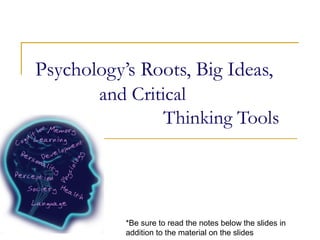Signaler
Partager

Recommandé
Recommandé
Contenu connexe
Tendances
Tendances (16)
Similaire à Psychology’s roots online
Similaire à Psychology’s roots online (20)
Fall 2014 psychology chapter 1 thinking critically with psychological science

Fall 2014 psychology chapter 1 thinking critically with psychological science
Use the Capella library to locate two psychology research articles.docx

Use the Capella library to locate two psychology research articles.docx
Understanding Psychology and schools of thoughts.pptx

Understanding Psychology and schools of thoughts.pptx
Dernier
Dernier (20)
2024: Domino Containers - The Next Step. News from the Domino Container commu...

2024: Domino Containers - The Next Step. News from the Domino Container commu...
AWS Community Day CPH - Three problems of Terraform

AWS Community Day CPH - Three problems of Terraform
Strategies for Unlocking Knowledge Management in Microsoft 365 in the Copilot...

Strategies for Unlocking Knowledge Management in Microsoft 365 in the Copilot...
Apidays New York 2024 - Scaling API-first by Ian Reasor and Radu Cotescu, Adobe

Apidays New York 2024 - Scaling API-first by Ian Reasor and Radu Cotescu, Adobe
Advantages of Hiring UIUX Design Service Providers for Your Business

Advantages of Hiring UIUX Design Service Providers for Your Business
Automating Google Workspace (GWS) & more with Apps Script

Automating Google Workspace (GWS) & more with Apps Script
Apidays Singapore 2024 - Building Digital Trust in a Digital Economy by Veron...

Apidays Singapore 2024 - Building Digital Trust in a Digital Economy by Veron...
Strategies for Landing an Oracle DBA Job as a Fresher

Strategies for Landing an Oracle DBA Job as a Fresher
Strategize a Smooth Tenant-to-tenant Migration and Copilot Takeoff

Strategize a Smooth Tenant-to-tenant Migration and Copilot Takeoff
Bajaj Allianz Life Insurance Company - Insurer Innovation Award 2024

Bajaj Allianz Life Insurance Company - Insurer Innovation Award 2024
The 7 Things I Know About Cyber Security After 25 Years | April 2024

The 7 Things I Know About Cyber Security After 25 Years | April 2024
Powerful Google developer tools for immediate impact! (2023-24 C)

Powerful Google developer tools for immediate impact! (2023-24 C)
HTML Injection Attacks: Impact and Mitigation Strategies

HTML Injection Attacks: Impact and Mitigation Strategies
Psychology’s roots online
- 1. Psychology’s Roots, Big Ideas, and Critical Thinking Tools *Be sure to read the notes below the slides in addition to the material on the slides
- 2. Chapter Objectives After covering this chapter, you should be able to: Identify 4 big ideas that run throughout psychology. Describe psychology’s current perspectives, and identify some of its subfields. Compare and contrast case studies, surveys, and naturalistic observation, and explain the importance of random sampling. Describe positive and negative correlations, and explain how correlational measures can aid the process of prediction but not provide evidence of cause-effect relationships. Explain how experiments help researchers isolate cause and effect, focusing on the characteristics of experimentation that make this possible
- 3. Psychology’s Roots Wilhelm Wundt – 1879 Psychology: the scientific study of behavior and mental processes Behavior Mental Processes Psychology’s sub-fields
- 5. Critical Thinking The Case of Andrea Yates Read the case below and try to explain Andrea’s behavior using as many perspectives as possible on the previous slide. Why did she murder her children?
- 6. Four Big Ideas in Psychology Critical Thinking Behavior is a biopsychosocial event We operate with a two-track mind (dual processing) Psychology explores human strengths as well as challenges
- 8. Review A newspaper article describes how a “cure for cancer has been found.” A critical thinker probably will a. dismiss the article as untrue. b. accept the information as a wonderful breakthrough. c. question the article, evaluate the evidence, and assess the conclusions. d. question the article but quickly accept it as true if the author has an excellent reputation.
- 9. Why do Psychology? 2 common flaws in intuitive thinking Hindsight bias Overconfidence
- 10. How do Psychologists Ask & Answer Questions? Scientific method Theory Hypothesis Operational definitions Replication
- 12. How do Psychologists Ask & Answer Questions? Description Case study The survey Wording Random sampling Naturalistic observation
- 13. How do Psychologists Ask & Answer Questions? Correlation Correlation coefficient CORRELATION DOES NOT PROVE CAUSATION Illusory correlations
- 14. Direction of correlations Positive correlations Negative correlations
- 15. Scatterplots Correlations can be represented by scatterplots.
- 16. Your turn What kind of correlation is this? 1. Positive 2. Negative 3. No correlation
- 18. How do Psychologists Ask & Answer Questions? Experimentation Variable Random assignment Experimental group Control group Double-blind procedure (eliminating bias) Placebo effect Independent variable Dependent variable
- 19. Name the independent and dependent variables A researcher was interested in the effects of reward on intrinsic motivation. Some children were told that they would be given a special award for drawing with magic markers (an activity they already enjoyed). Other children were simply asked to draw with the magic markers. One week later, the children were unobtrusively observed for how much time they spent drawing with the markers. The children who expected and received a reward for drawing with the markers were less likely to draw with them later.
- 20. Review Descriptive and correlational studies describe behavior, detect relationships, and predict behavior. But in order to begin to explain behavior, psychologists use a. naturalistic observations. b. experiments. c. surveys. d. case studies.
- 21. Chapter Objectives After covering this chapter, you should be able to: Identify 4 big ideas that run throughout psychology. Describe psychology’s current perspectives, and identify some of its subfields. Compare and contrast case studies, surveys, and naturalistic observation, and explain the importance of random sampling. Describe positive and negative correlations, and explain how correlational measures can aid the process of prediction but not provide evidence of cause-effect relationships. Explain how experiments help researchers isolate cause and effect, focusing on the characteristics of experimentation that make this possible